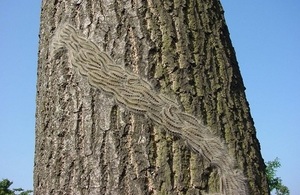Tighter restrictions on oak tree imports come into force
Tighter measures on the import of oak trees come into force in England to protect the country against oak processionary moth

Forestry Commission
Strengthened measures on the import of most species of oak into England were introduced to protect native trees from the threat of the tree pest Oak Processionary Moth (OPM) on Monday 15 July.
The bolstered measures will only permit imports of certain oak trees, including:
- those from OPM free countries
- those from designated pest free areas including Protected Zones (PZ) - an area of the European Union declared free of OPM
- those that have been grown under complete physical protection for their lifetime.
This Statutory Instrument (SI) builds on measures introduced in August 2018 and applies to all oak trees, except cork oak, over a certain size. This is because these trees represent the greatest likelihood of introducing OPM into the UK PZ, as they are more susceptible to pest populations and more difficult to inspect.
The restrictions will cover both imports from overseas and the movement of trees from areas of the country where OPM is already present – in London and surrounding counties.
Biosecurity Minister Lord Gardiner said:
Biosecurity is absolutely key to everything we do and we must to do more to stop pests and diseases crossing continents and borders. That is why as a country we have more protected zones than anywhere else in the EU.
It is essential that we further strengthen our import controls on oak trees. These new measures will ensure robust protections for our oak trees from pests such as the Oak Processionary Moth.
OPM caterpillars feed on oak leaves and can increase trees’ vulnerability to attack by other pests and diseases making them less able to withstand adverse weather conditions, such as drought and floods.
Nicola Spence, Defra Chief Plant Health Officer said:
Since 2012 we have invested more than £37 million in tree health research, including a dedicated programme of research and development on oak.
We will continue to work with local authorities and land managers to tackle OPM in areas where it is present with a control programme of treatment and surveillance. These strengthened measures will help protect against further arrivals of the pest on our shores.
The Plant Health Service has received reports of an exceptional expansion of the OPM population in parts of Europe due to the hot weather experienced last year.
Woodland managers, land owners, the forest industry and tree nurseries are being urged to remain vigilant after the Plant Health Service intercepted findings of Oak Processionary Moth (OPM) caterpillars on trees recently imported from the Netherlands, and are being asked to urgently check recently planted large oak trees.
Dr Anna Brown, Head of Tree Health & Contingency Planning, Forestry Commission, said:
Those of us involved in importing or trading plants must maintain our vigilance against exotic pests and diseases such as OPM. There is a lot we can do such as buying British, only buying stock from reputable, responsible suppliers and inspecting imported plants.
These stronger requirements will increase our protection but my message remains the same: inspect, inspect and inspect again. We can’t check imported plants too often for signs of trouble. Don’t presume that because your supplier found no evidence of a pest or disease that you won’t either. You might spot something that they have missed.
If you suspect OPM, you should not attempt to destroy or move infected material yourself as the nests and caterpillars can pose some risks to human health.
Visit the Forest Research website for more information on how to identify OPM. To report sightings of pests and diseases, use the TreeAlert online portal.
The Forestry Commission, councils and land managers tackle the pest which affects Greater London and several surrounding counties with an annual control programme of treatment.